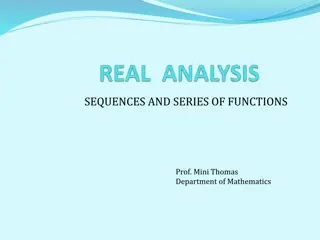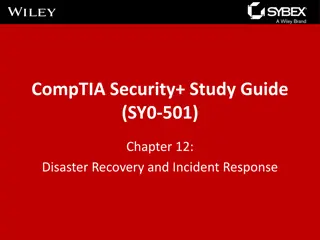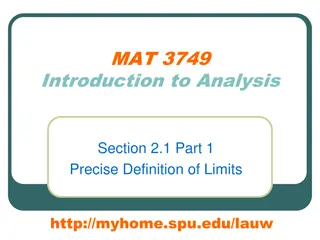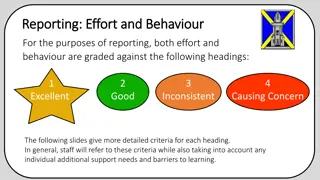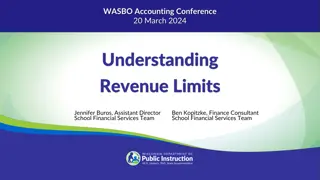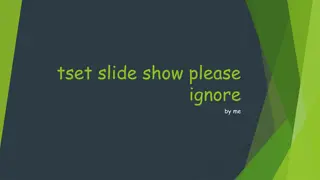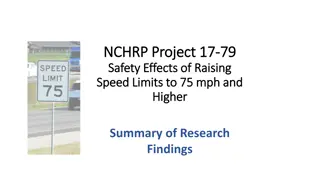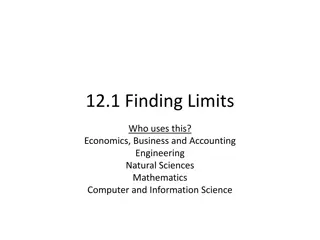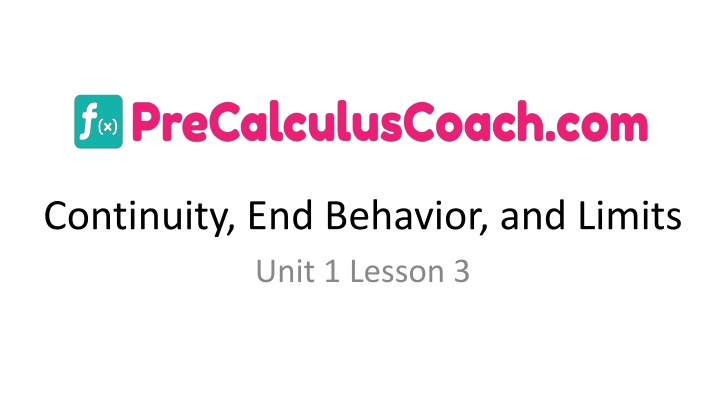
Continuity, End Behavior, and Limits
Explore the concepts of continuity, end behavior, and limits in functions through graphs and tables. Learn about discontinuities, limits, and different types of discontinuities like infinite, jump, and removable. Strengthen your understanding of key features of graphs and the behavior of functions.
Download Presentation

Please find below an Image/Link to download the presentation.
The content on the website is provided AS IS for your information and personal use only. It may not be sold, licensed, or shared on other websites without obtaining consent from the author. If you encounter any issues during the download, it is possible that the publisher has removed the file from their server.
You are allowed to download the files provided on this website for personal or commercial use, subject to the condition that they are used lawfully. All files are the property of their respective owners.
The content on the website is provided AS IS for your information and personal use only. It may not be sold, licensed, or shared on other websites without obtaining consent from the author.
E N D
Presentation Transcript
Continuity, End Behavior, and Limits Unit 1 Lesson 3
Continuity, End Behavior, and Limits Students will be able to: Interpret key features of graphs and tables in terms of the quantities, and sketch graphs showing key features given a verbal description of the relationship. Key Vocabulary: Discontinuity, A limit, End Behavior
Continuity, End Behavior, and Limits The graph of a continuous function has no breaks, holes, or gaps. You can trace the graph of a continuous function without lifting your pencil. One condition for a function ? ? to be continuous at ? = ? is that the function must approach a unique function value as ? -values approach ? from the left and right sides.
Continuity, End Behavior, and Limits The concept of approaching a value without necessarily ever reaching it is called a limit. If the value of ? ? approaches a unique value ?as ? approaches ? from each side, then the limit of ? ? as ? approaches ? is?. ??? ? ? ? ? = ?
Continuity, End Behavior, and Limits Functions that are not continuous are discontinuous. Graphs that are discontinuous can exhibit: Infinite discontinuity A function has an infinite discontinuity at ? = ?, if the function value increases or decreases indefinitely as ? approaches?from the left and right.
Continuity, End Behavior, and Limits Functions that are not continuous are discontinuous. Graphs that are discontinuous can exhibit: Jump discontinuity A function has a jump discontinuity at ? = ? if the limits of the function as ? approaches ? from the left and right exist but have two distinct values.
Continuity, End Behavior, and Limits Functions that are not continuous are discontinuous. Graphs that are discontinuous can exhibit: Removable discontinuity, also called point discontinuity Function has a removable discontinuity if the function is continuous everywhere except for a hole at ? = ?. .
Continuity, End Behavior, and Limits Continuity Test A function ? ? is continuousat ? = ?, if it satisfies the following conditions: 1. 1. ? ? is defined at c. ?(?)exists. 2. 2. ? ? approaches the same function value to the left and right of?.??? ? ? ? ? ?????? 3. The function value that? ? approaches from each side of?is? ? . ??? ? ? ? ? = ?(?) .
Continuity, End Behavior, and Limits Sample Problem 1: Determine whether each function is continuous at the given x -values. Justify using the continuity test. If discontinuous, identify the type of discontinuity. a. ? ? = ???+ ? ? ?? ? = ? y 30 20 10 x -40 -30 -20 -10 10 20 30 40 -10 -20 -30
Continuity, End Behavior, and Limits Sample Problem 1: Determine whether each function is continuous at the given x -values. Justify using the continuity test. If discontinuous, identify the type of discontinuity. a. ? ? = ???+ ? ? ?? ? = ? ? ? = ? ??+ ? ? = ? y 30 ? ? ?????? 20 10 x -40 -30 -20 -10 10 20 30 40 -10 -20 -30
Continuity, End Behavior, and Limits Sample Problem 1: Determine whether each function is continuous at the given x -values. Justify using the continuity test. If discontinuous, identify the type of discontinuity. a. ? ? = ???+ ? ? ?? ? = ? ? ? ? ? y 30 20 ? ?.? ?.?? ?.??? 10 x ? ? ?.?? ?.???? ?.?????? -40 -30 -20 -10 10 20 30 40 -10 -20 -30
Continuity, End Behavior, and Limits Sample Problem 1: Determine whether each function is continuous at the given x -values. Justify using the continuity test. If discontinuous, identify the type of discontinuity. a. ? ? = ???+ ? ? ?? ? = ? ? ?+ ? ? y 30 20 ? ?.? ?.?? ?.??? 10 x ? ? ?.?? ?.???? ?.?????? -40 -30 -20 -10 10 20 30 40 -10 -20 -30
Continuity, End Behavior, and Limits Sample Problem 1: Determine whether each function is continuous at the given x -values. Justify using the continuity test. If discontinuous, identify the type of discontinuity. a. ? ? = ???+ ? ? ?? ? = ? ? ? = ? ??? ? ? ???? ???? ???? ?? ? = ? y 30 20 ? ? ???+ ? ? = ?(?) ? ? = ???+ ? ? ?? ?????????? ?? ? = ? 10 ??? x -40 -30 -20 -10 10 20 30 40 -10 -20 -30
Continuity, End Behavior, and Limits Sample Problem 1: Determine whether each function is continuous at the given x -values. Justify using the continuity test. If discontinuous, identify the type of discontinuity. ?? ? y b. ? ? = ?? ? = ? 5 4 3 2 1 x -5 -4 -3 -2 -1 1 2 3 4 5 -1 -2 -3 -4 -5
Continuity, End Behavior, and Limits Sample Problem 1: Determine whether each function is continuous at the given x -values. Justify using the continuity test. If discontinuous, identify the type of discontinuity. ?? ? y b. ? ? = ?? ? = ? ? ? ? =? 5 ? ? = 4 ? 3 ??? ???????? ?? ????????? ?? ? = ? 2 1 x -5 -4 -3 -2 -1 1 2 3 4 5 -1 -2 -3 -4 -5
Continuity, End Behavior, and Limits Sample Problem 1: Determine whether each function is continuous at the given x -values. Justify using the continuity test. If discontinuous, identify the type of discontinuity. ?? ? y b. ? ? = ?? ? = ? ? ? ? ? 5 4 ? ?.? ?.?? ?.??? 3 2 ? ? ? ? ? 1 x -5 -4 -3 -2 -1 1 2 3 4 5 -1 -2 -3 -4 -5
Continuity, End Behavior, and Limits Sample Problem 1: Determine whether each function is continuous at the given x -values. Justify using the continuity test. If discontinuous, identify the type of discontinuity. ?? ? y b. ? ? = ?? ? = ? ? ?+ ? ? 5 4 3 ? ?.? ?.?? ?.??? 2 1 x ? ? ? ? ? -5 -4 -3 -2 -1 1 2 3 4 5 -1 -2 -3 -4 -5
Continuity, End Behavior, and Limits Sample Problem 1: Determine whether each function is continuous at the given x -values. Justify using the continuity test. If discontinuous, identify the type of discontinuity. ?? ? y b. ? ? = ?? ? = ? ?? ? 5 ? ? = 4 3 2 ??? ???? ????????????? ?? ? = ? 1 x -5 -4 -3 -2 -1 1 2 3 4 5 ????? ? ?????? ??? ? ??? ? ?? ???????? ????? ?? ? = ? -1 -2 -3 -4 -5
Continuity, End Behavior, and Limits Sample Problem 1: Determine whether each function is continuous at the given x -values. Justify using the continuity test. If discontinuous, identify the type of discontinuity. ? ? =?? ? ? + ? ?? ? = ? c. y 5 4 3 2 1 x -5 -4 -3 -2 -1 1 2 3 4 5 -1 -2 -3 -4 -5
Continuity, End Behavior, and Limits Sample Problem 1: Determine whether each function is continuous at the given x -values. Justify using the continuity test. If discontinuous, identify the type of discontinuity. ? ? =?? ? ? + ? c. ?? ? = ? ?? ? ? + ? =? ? ? = y 5 ? 4 3 ? ? ?? ????????? ?? ? = ? ? ? =?? ? ? + ? ?? ????????????? ?? ? = ? 2 1 x -5 -4 -3 -2 -1 1 2 3 4 5 -1 -2 -3 -4 -5
Continuity, End Behavior, and Limits Sample Problem 1: Determine whether each function is continuous at the given x -values. Justify using the continuity test. If discontinuous, identify the type of discontinuity. ? ? =?? ? ? + ? ?? ? = ? c. ? ? ? ? y 5 4 3 ? ?.? ?.?? ?.??? 2 1 x ? ? ?.? ?.?? ?.??? -5 -4 -3 -2 -1 1 2 3 4 5 -1 -2 -3 -4 -5
Continuity, End Behavior, and Limits Sample Problem 1: Determine whether each function is continuous at the given x -values. Justify using the continuity test. If discontinuous, identify the type of discontinuity. ? ? =?? ? ? + ? c. ?? ? = ? ? ?+ ? ? y 5 4 ? ?.? ?.?? ?.??? 3 2 1 x ? ? ?.? ?.?? ?.??? -5 -4 -3 -2 -1 1 2 3 4 5 -1 -2 -3 -4 -5
Continuity, End Behavior, and Limits Sample Problem 1: Determine whether each function is continuous at the given x -values. Justify using the continuity test. If discontinuous, identify the type of discontinuity. ? ? =?? ? ? + ? ? ? =?? ? c. ?? ? = ? y 5 ? + ? 4 3 ??? ????? ????????????? ?? ? = ? 2 1 x ????? ? ????? ?? ? ?? ???????? ????? ?? ? = ? -5 -4 -3 -2 -1 1 2 3 4 5 -1 -2 -3 -4 -5
Continuity, End Behavior, and Limits Sample Problem 1: Determine whether each function is continuous at the given x -values. Justify using the continuity test. If discontinuous, identify the type of discontinuity. ? ??? y ? ? = ?? ? = ? d. 5 4 3 2 1 x -5 -4 -3 -2 -1 1 2 3 4 5 -1 -2 -3 -4 -5
Continuity, End Behavior, and Limits Sample Problem 1: Determine whether each function is continuous at the given x -values. Justify using the continuity test. If discontinuous, identify the type of discontinuity. ? ??? y ? ? = ?? ? = ? d. ? 5 ? ? = ? ??= 4 3 ? ? ?? ????????? ?? ? = ? ? ??? ?? ????????????? ?? ? = ? 2 1 x -5 -4 -3 -2 -1 1 2 3 4 5 ? ? = -1 -2 -3 -4 -5
Continuity, End Behavior, and Limits Sample Problem 1: Determine whether each function is continuous at the given x -values. Justify using the continuity test. If discontinuous, identify the type of discontinuity. ? ??? y ? ? = ?? ? = ? d. ? ? ? + 5 4 3 ? ?.? ?.?? ?.??? 2 1 x ? ? ??.?? ?,???.?? ???,???.?? -5 -4 -3 -2 -1 1 2 3 4 5 -1 -2 -3 -4 -5
Continuity, End Behavior, and Limits Sample Problem 1: Determine whether each function is continuous at the given x -values. Justify using the continuity test. If discontinuous, identify the type of discontinuity. ? ??? y ? ? = ?? ? = ? d. ? ?+ ? + 5 4 3 ? ?.? ?.?? ?.??? 2 1 x ? ? ??.?? ?,???.?? ???,???.?? -5 -4 -3 -2 -1 1 2 3 4 5 -1 -2 -3 -4 -5
Continuity, End Behavior, and Limits Sample Problem 1: Determine whether each function is continuous at the given x -values. Justify using the continuity test. If discontinuous, identify the type of discontinuity. ? ??? y ? ? = ? ? = ?? ? = ? d. ? ??? 5 4 ??? ???????? ????????????? ?? ? = ? ????? ? ????? ?? + ???? ? ? 3 2 1 x -5 -4 -3 -2 -1 1 2 3 4 5 -1 -2 -3 -4 -5
Continuity, End Behavior, and Limits Intermediate Value Theorem If ? ? is a continuous function and ? < ? and there is a value ? such that ? is between ? ? and ? ? , then there is a number ?, such that ? < ? < ? and ? ? = ?
Continuity, End Behavior, and Limits The Location Principle If ? ? is a continuous function and ? ? and ? ? have opposite signs, then there exists at least one value ?, such that ? < ? < ? and ? ? = ?. That is, there is a zero between ? and ?.
Continuity, End Behavior, and Limits Sample Problem 2: Determine between which consecutive integers the real zeros of function are located on the given interval. ? ? = ? ?? ? a. [?,?] y 5 4 3 2 1 x -5 -4 -3 -2 -1 1 2 3 4 5 -1 -2 -3 -4 -5
Continuity, End Behavior, and Limits Sample Problem 2: Determine between which consecutive integers the real zeros of function are located on the given interval. a. ? ? = ? ?? ? [?,?] ? ? ? ? ? ? ? ? y 5 ? ? ? ? ? ? ? ? 4 3 ? ? is positive and ? ? is negative, ? ? ?????? ???? ??? ? ? ? ? is negative and ? ? is positive, ? ? ?????? ???? ?? ? ? ? ? ?has zeros in intervals: ? ? ? ??? ? ? ? 2 1 x -5 -4 -3 -2 -1 1 2 3 4 5 -1 -2 -3 -4 -5
Continuity, End Behavior, and Limits End Behavior The end behavior of a function describes what the ? - values do as ? becomes greater and greater. When ? becomes greater and greater, we say that ? approaches infinity, and we write ? + . When ? becomes more and more negative, we say that ? approaches negative infinity, and we write ? .
Continuity, End Behavior, and Limits The same notation can also be used with ? or ? ? and with real numbers instead of infinity. Left - End Behavior (as ? becomes more and more negative): ??? ? ? ? Right - End Behavior (as ? becomes more and more positive): ??? ? + ? ? The ? ? values may approach negative infinity, positive infinity, or a specific value.
Continuity, End Behavior, and Limits Sample Problem 3: Use the graph of each function to describe its end behavior. Support the conjecture numerically. ? ? = ???+ ?? ? a. y 8 7 6 5 4 3 2 1 x -9 -8 -7 -6 -5 -4 -3 -2 -1 1 2 3 4 5 6 7 8 9 -1 -2 -3 -4 -5 -6 -7 -8
Continuity, End Behavior, and Limits Sample Problem 3: Use the graph of each function to describe its end behavior. Support the conjecture numerically. ? ? = ???+ ?? ? a. From the graph, it appears that: y 8 7 ? ? ?? ? ? ? ?? ? 6 5 4 3 2 The table supports this conjecture. ??? ??? ? 1 x -9 -8 -7 -6 -5 -4 -3 -2 -1 1 2 3 4 5 6 7 8 9 ??? ??? -1 ? -2 -3 -4 ? ???? ? ??? -? ??? -? ???? ? ? -5 -6 -7 -8
Continuity, End Behavior, and Limits Sample Problem 3: Use the graph of each function to describe its end behavior. Support the conjecture numerically. ? ? =?? ? ? ? y b. 12 10 8 6 4 2 x -14 -12 -10 -8 -6 -4 -2 2 4 6 8 10 12 14 -2 -4 -6 -8 -10 -12
Continuity, End Behavior, and Limits Sample Problem 3: Use the graph of each function to describe its end behavior. Support the conjecture numerically. ? ? =?? ? ? ? y b. From the graph, it appears that: ? ? ? ?? ? ? ? ? ?? ? 12 10 8 6 4 The table supports this conjecture. 2 x ??? ??? ??? ??? ? ? -14 -12 -10 -8 -6 -4 -2 2 4 6 8 10 12 14 -2 -4 ? ?.???? ?.???? ?.?? ?.??? ?.???? -6 -8 -10 -12
Continuity, End Behavior, and Limits Increasing, Decreasing, and Constant Functions A function ? is increasing on an interval ? if and only if for every ? and ? contained in ?, ? < ? ? , whenever ? < ? . A function ? is decreasing on an interval ? if and only if for every ? and ? contained in ?, ? ? > ? ? whenever ? < ? . A function ? remains constant on an interval ? if and only if for every ? and ? contained in ?, ? ? = ? ? whenever ? < ? . Points in the domain of a function where the function changes from increasing to decreasing or from decreasing to increasing are called critical points.
Continuity, End Behavior, and Limits Sample Problem 4: Determine the interval(s) on which the function is increasing and the interval(s) on which the function is decreasing. ? ? = ?? ?? + ? a. y 5 4 3 2 1 x -5 -4 -3 -2 -1 1 2 3 4 5 -1 -2 -3 -4 -5
Continuity, End Behavior, and Limits Sample Problem 4: Determine the interval(s) on which the function is increasing and the interval(s) on which the function is decreasing. ? ? = ?? ?? + ? From the graph, it appears that: A function ?? ?? + ? is decreasing for ? < ?.? A function ?? ?? + ? is increasing for ? > ?.? a. y 5 4 3 2 1 x -5 -4 -3 -2 -1 1 2 3 4 5 -1 -2 -3 -4 -5
Continuity, End Behavior, and Limits Sample Problem 4: Determine the interval(s) on which the function is increasing and the interval(s) on which the function is decreasing. ? ? = ?? ?? + ? a. y 5 The table supports this conjecture. 4 ? ? ? ? ?.? ? ? 3 2 1 ? ? ? ? ?.?? ?.? ? x -5 -4 -3 -2 -1 1 2 3 4 5 -1 -2 -3 -4 -5
Continuity, End Behavior, and Limits Sample Problem 4: Determine the interval(s) on which the function is increasing and the interval(s) on which the function is decreasing. ? ? = ?? ? ??? ??? + ? y b. 12 10 8 6 4 2 x -14 -12 -10 -8 -6 -4 -2 2 4 6 8 10 12 14 -2 -4 -6 -8 -10 -12
Continuity, End Behavior, and Limits Sample Problem 4: Determine the interval(s) on which the function is increasing and the interval(s) on which the function is decreasing. ? ? = ?? ? ??? ??? + ? y From the graph, it appears that: A function ?? ? is increasing: ? < ?.?? ??? ? > ? A function ?? ? is decreasing: ?.?? < ? < ? b. 12 ??? ??? + ? 10 8 6 4 2 x ??? ??? + ? -14 -12 -10 -8 -6 -4 -2 2 4 6 8 10 12 14 -2 -4 -6 -8 -10 -12
Continuity, End Behavior, and Limits Sample Problem 4: Determine the interval(s) on which the function is increasing and the interval(s) on which the function is decreasing. ? ? = ?? ? ??? ??? + ? y The table supports this conjecture. b. 12 10 ? ? ?.?? ? ? ? ? 8 6 4 2 x ? ?? ??.?? ??.? ? ?? ?.? -14 -12 -10 -8 -6 -4 -2 2 4 6 8 10 12 14 -2 -4 -6 -8 -10 -12




